Vowel Lessons:
To Help Improve Your Spelling
Watch this video as an alternative to reading the page.
The vowel lessons on this page will help you boost your spelling capacity. I find most of my spelling mistakes are due to vowels. For me they are harder to clearly define than consonants.
Vowels work in very interesting ways to represent sound both on their own and blended together. This, however, can be confusing for dyslexic people. Therefore I’m going to show you my favourite techniques to make vowels more distinctive and memorable. This page will work well in conjunction with How to Remember Any Word.
Important point: don’t look for rules look for patterns:
In the past rules have been applied to help people learn English, for example, ‘i’ before ‘e’ except after ‘c’. With the English language, though, there is no point trying to establish rules, as all the rules are made to be broken.
English follows patterns of letter combinations. For example you are very likely to find the letters, ‘ea’ or, ‘ee’ in the middle of a word in English, but you won’t find the letters ‘aa’ together.
If you haven’t done already I highly recommend you learn the phonic alphabetic code chart. This will show you all the letter pattern combinations.
Vowel lesson 1: General stuff:
The English Vowels are, ‘A’, E’, ‘I’, ‘O’, ‘U’, these are the five main ones. Sometimes ‘Y’ makes a vowel sound but don’t worry about that, just focus on the first five.
Vowel lesson 2: How they represent sounds:
- Obviously the lowercase vowel letters will represent lowercase sounds.
For example (see graphic)
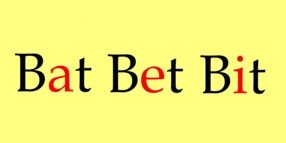
- Sometimes a lowercase vowel will represent its uppercase (capital) sound.
For example (see graphic)
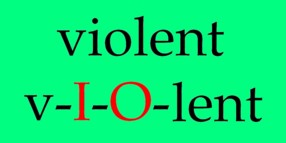
and

- In a lot of words they will work in pairs to make one sound. (see graphic)
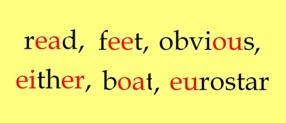
Vowel lesson 3: Make them easier to remember by giving them human characteristics:
Like I’ve said, I make most of my spelling mistakes as a result of the vowels. I needed a way to make them more memorable, so I gave them human characteristics.
You may think this sound silly, and you’d be right, but it can really improve your spelling.
This is what I think when I look at each of the vowels:
a = big belly, e = happy, i = skinny, o = surprised, u = a bit sick and miserable (see graphic).
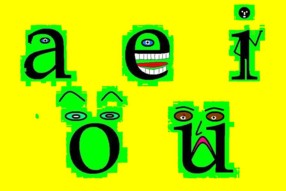
These are the human characteristics that occur to me when I look at the shapes of the letters.
Feel free to give them other characteristics, if you like.
Example
I use to misspell the word ‘character’ (this is the correct spelling)
Half the time I would spell it ‘charactor’.
If you look at my misspelling there is only one incorrect letter. To correct it I only needed to make the ‘e’ distinctive.
To make the ‘e’ memorable I think of it as a smiley face. The shape of the ‘e’ looks a bit like a smile where it curves at the bottom. When a person is described as a character they are usually a happy smiley person. This is how I associate the ‘e’ with the word character.
Vowel lesson 4: Focus on only the vowels:
When I’m learning to spell a new word the first thing I do is focus on only the vowels (see graphic). For example while writing this website I remember misspelling the word ‘sentence’. If we look at only the vowels in the word ‘sentence’ we can see they are all ‘e’s.

This for me makes the word very easy to spell.
Here's another example.
I can often get the vowels in a word mixed up. The word ‘separate’ has two ‘e’s one at the start and one at the end, with two ‘a’s in the middle (see graphic). Thinking about a word in this way stops me from getting confused the next time I come to spell it
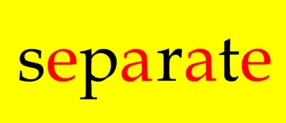
Conclusion:
Taking a second to pay attention to only the vowels in words helps me remember how they are spelt. It gives me an extra layer of memory. Click here to find out how you can use the weird bits of the English language to improve your spelling.
The English vowels are strange little things. I can easily get their sounds mixed up with each other. Making them more visually distinctive helps me immensely. Click here for more spelling help.
Return from Vowel Lessons to Home page.